
The Deactivation and Decommissioning Focus Area has a new lead. Bob Bedick, who has been head of National Energy Technology Laboratory’s Industry and University Programs, is now also DDFA lead. Paul Hart, the previous focus area lead, has become the associate director of NETL’s Office of Environmental Management and Defense Programs. LSDDP model validated
The LSDDP that concluded in December 1999 at the Savannah River Site 321-M Fuel Fabrication Facility has been recognized for its success in transferring new technologies and know-how to the DOE complex and commercial users. The winning of a 2000 DOE Pollution Prevention Award by the SRS LSDDP validates the impact the DDFA LSDDP model is having in promoting superior technologies and processes that increase cost savings and improve worker safety and schedule acceleration across the DOE complex. In FY99, DDFA scored 61 deployments of 19 different technologies, capitalizing on the experience of its four completed LSDDPs at the Chicago Pile 5 Research Reactor at Argonne National Laboratory–East, the Fernald Environmental Management Project Plant 1 Complex, the Hanford C Reactor, as well as its Savannah River LSDDP. At the SRS LSDDP, five characterization, decontamination, and dismantlement technologies were demonstrated and three were subsequently selected for a continuing role in the cleanup of the 321-M Fuel Fabrication Facility. Due to their contributions to safety and cost-effectiveness, ALARA 1146 Strippable Coating, the Size Reduction Machine, and E-PERM Electret Ion Chamber have joined the D&D effort at Savannah River.
Size Reduction Machine (OST/TMS ID 2395) improves the safety and efficiency of dismantlement and waste handling operations by creating smaller waste that is easier to handle and uses fewer waste containers. It is a manually positioned, remotely operated hydraulic shear capable of cutting up to 15 feet above floor level. The hydraulic shears can cut 3-inch by 3-inch stainless steel angles, 4-inch schedule 40 pipes, or a 3.5-inch by 0.5-inch flat bar. E-PERM Electret Ion Chamber (OST/TMS ID 2315) will be featured in the Winter 2000 issue. Ongoing LSDDPs
Mound Tritium Facilities in Miamisburg, Ohio. Technologies are being demonstrated for the decommissioning of over 1,000 linear feet of tritium gloveboxes, fume hoods, miles of process piping, and other tritiated components in buildings containing 275,000 square feet of floor space and over 400 tritium laboratories. Among the technologies that have been demonstrated are the Lumi-Scint Scintillation Counter, Water Solidification, Oil Solidification, the Tritium Clean-up Cart, and the Pipe Cutting and Crimping System. Two of these technologies have been subsequently deployed at Mound—the Lumi-Scint Liquid Scintillation Counter and Water Solidification.
INEEL Fuel Storage Canals and Associated Underwater and Underground Facilities LSDDP. The LSDDP at Idaho National Engineering and Environmental Laboratory (INEEL) includes decommissioning of the Advanced Reactor Material Facility and Couple Fast Reactivity Measurement Facility underwater reactors with interconnecting water canal, filter pits located underground in confined-entry areas, and the Initial Engine Test Control Room in Test Area North 620. The INEEL LSDDP has successfully demonstrated a number of technologies, which in turn have been subsequently deployed:
Speeding deployments with ASTD
projects Reducing, Reusing, and Recycling Concrete and Segmenting Plate Steel and Tanks Utilizing a Universal Demolition Processor (OST/TMS ID 2981). As D&D work at Fernald progresses from above-grade facilities to at-grade and below-grade facilities, there will be a need for new technologies to process concrete. The universal processor technology is three different technologies in one. The universal processor, via exchanging jaw sets, can be a concrete pulverizer, concrete cracker, or a shear capable of cutting up thick plate steel. The universal processor technology will be attached to the track-mounted carrier. Fernald can realize significant cost savings by reprocessing and reusing a portion of the site’s concrete. Just using recycled concrete instead of purchasing and later disposing of 50,000 cubic yards of aggregate over the next six years would yield an estimated cost saving of $2,800,000—a return on investment (ROI) of 3.5. Deploying a Real-Time Physiological Monitoring System (OST/TMS ID 2984), a Remote Prismless Total Station (OST/TMS ID 2983), and a Wireless, Integrated Radon Monitoring System (OST/TMS ID 2985). As environmental cleanup work at the Fernald Environmental Management Project (FEMP) accelerates toward closure and long-term stewardship, there is an increasing need for new, innovative technologies to perform real-time physiological monitoring, radon monitoring, and land survey measurements. The Real-Time Physiological Monitoring System (RTPMS) is designed to monitor the vital signs of individual workers as they perform work in extreme conditions. A wireless communications system for the remote transmission of radon monitoring data and the daily operability inspections of air monitoring stations has been identified. Land survey measurements are required to support engineering, construction, and environmental restoration activities. While the RTPMS’s ROI is in worker health and safety, using a Remote Prismless Total Station over the next six years at FEMP could save DOE $370,500—an ROI of 3.0. Based upon a life-cycle cost estimate of seven years of environmental monitoring activities, using a wireless communication system to electronically transmit environmental data could yield approximately $775,000—an ROI of 3.0.
Remote In Situ Reduction of Plutonium-Contaminated Gloveboxes and Equipment. This new ASTD project supports the deployment of a number of improved tools at RFETS for the removal of large plutonium-contaminated gloveboxes and equipment that must be sized reduced in place. These improved tools compose the In Situ Size Reduction System (ISSRS) for automated size-reduction activities. The ISSRS will minimize personnel radiation dose and enhance safety, while providing an estimated life-cycle savings of $13.7 million. Upgrade RAD Instrumentation at RFETS. This new ASTD project will support the deployment of a broad array of state-of-the-art instrumentation technology to accelerate baseline D&D activities, improve worker safety, and significantly reduce RFETS closure costs. Possible technologies to be deployed include the Long-Range Alpha Detector, an improved 3-D gamma imaging system, a glovebox failure alarm system, systems for automated waste inspection and tracking, and a beryllium air monitor. Life-cycle cost savings for this ASTD are estimated in excess of $12 million. Deploying Diamond Wire Saw Demolition and Size Reduction of a Reactor Bioshield. This new ASTD project will deploy a proven diamond wire saw technology to size reduce an activated bioshield and associated structures of a decommissioned research reactor at Battelle’s West Jefferson Site. Target structures for the diamond wire saw include large radioactive steel structures as well as internally activated, highly enforced concrete monoliths. The time and labor savings of the diamond wire technology will lead to significant cost savings for the Columbus Environmental Management Project over the current baseline of jackhammers, wrecking ball, and pulverizers. This deployment is expected to provide a cost savings of approximately $271K. Intrusive and Nonintrusive Characterization through Concrete Walls. This project will deploy a suite of innovative characterization, subsurface access, and modeling and visualization tools to expedite advanced characterization of the Old Cave—the entombed remains of a 1950s hot cell—at the Miamisburg Environmental Management Project (MEMP). The Old Cave is a critical path item for determining the final MEMP closure date. Some of the technologies that will be deployed include the In Situ Object Counting System, Pipe Explorer™ and SEAMIST™, Diamond Core Drilling, Ground Penetrating Radar and Time-Domain Electronics, and a small-footprint Geoprobe with a real-time position location determination device. Early deployment of the innovative characterization technologies has the potential to save up to $13 million. For further information, contact Bob Bedick, DDFA lead, at DOE’s National Energy Technology Laboratory, (304) 285-4505, or visit the DDFA Web site at www.netl.doe.gov/dd.
|

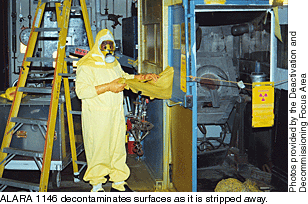 ALARA 1146 Strippable Coating (
ALARA 1146 Strippable Coating (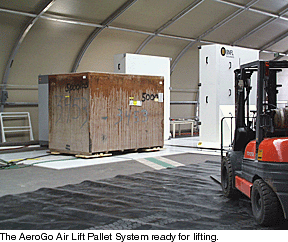 control box to "float" loads on a virtually frictionless
film of air. The reduced friction and omni-directional movement allow the operator to
precisely place and align the load in a limited workspace. The low profile of the
Aero-Caster Load Module requires less than 3 inches of clearance for positioning. Lifting
capacity is dependent upon the design, and air pressure can range from a few hundred
pounds to hundreds of tons. Once loads are elevated, only moderate force is needed to
maneuver and position a load. Loads can be accurately positioned as needed for
nondestructive assay analysis or for dismantlement.
control box to "float" loads on a virtually frictionless
film of air. The reduced friction and omni-directional movement allow the operator to
precisely place and align the load in a limited workspace. The low profile of the
Aero-Caster Load Module requires less than 3 inches of clearance for positioning. Lifting
capacity is dependent upon the design, and air pressure can range from a few hundred
pounds to hundreds of tons. Once loads are elevated, only moderate force is needed to
maneuver and position a load. Loads can be accurately positioned as needed for
nondestructive assay analysis or for dismantlement. 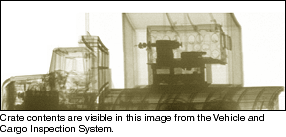
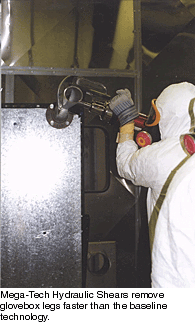 Legs on gloveboxes are typically either
3-inch-diameter pipe or unistrut. During the demonstration, the Mega-Tech hydraulic
cutting shear cut eight pipe legs in 15 minutes, while the baseline technology, a
reciprocating saw, took 45 to 60 minutes to cut through eight legs, including a rest break
to alleviate worker fatigue. Despite its lower production rate, the reciprocating saw may
be favored in confined spaces, because it does not require as much access room as the
hydraulic shears. Based on the faster production rate of the hydraulic shear, LANL and
Rocky Flats are expected to begin using the hydraulic shear as their new baseline
technology to remove legs from over 1,500 plutonium gloveboxes at the two sites.
Legs on gloveboxes are typically either
3-inch-diameter pipe or unistrut. During the demonstration, the Mega-Tech hydraulic
cutting shear cut eight pipe legs in 15 minutes, while the baseline technology, a
reciprocating saw, took 45 to 60 minutes to cut through eight legs, including a rest break
to alleviate worker fatigue. Despite its lower production rate, the reciprocating saw may
be favored in confined spaces, because it does not require as much access room as the
hydraulic shears. Based on the faster production rate of the hydraulic shear, LANL and
Rocky Flats are expected to begin using the hydraulic shear as their new baseline
technology to remove legs from over 1,500 plutonium gloveboxes at the two sites. 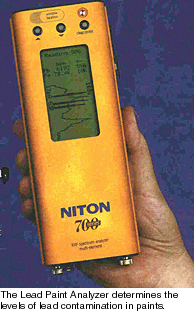 Lead Paint Analyzer (
Lead Paint Analyzer (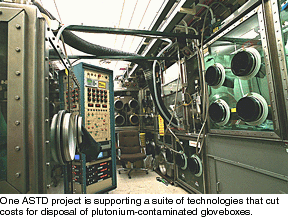 Decontamination of
Gloveboxes, Tanks, and Equipment for Shipment and Disposal without Reductions.
This new ASTD project at Rocky Flats Environmental Technology Site (RFETS) supports the
deployment of a suite of decontamination technologies for shipping and disposing of
plutonium-contaminated gloveboxes and equipment while obviating size-reduction
requirements. If surface contamination is reduced, gloveboxes and other equipment can be
disposed of as low-level waste per U.S. Department of Transportation criteria, thus
minimizing the total waste volume of material to be shipped to the Waste Isolation Pilot
Plant. Total cost savings to the site’s life-cycle baseline is estimated at $45.2
million.
Decontamination of
Gloveboxes, Tanks, and Equipment for Shipment and Disposal without Reductions.
This new ASTD project at Rocky Flats Environmental Technology Site (RFETS) supports the
deployment of a suite of decontamination technologies for shipping and disposing of
plutonium-contaminated gloveboxes and equipment while obviating size-reduction
requirements. If surface contamination is reduced, gloveboxes and other equipment can be
disposed of as low-level waste per U.S. Department of Transportation criteria, thus
minimizing the total waste volume of material to be shipped to the Waste Isolation Pilot
Plant. Total cost savings to the site’s life-cycle baseline is estimated at $45.2
million.